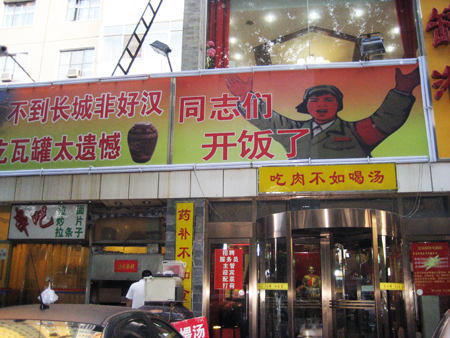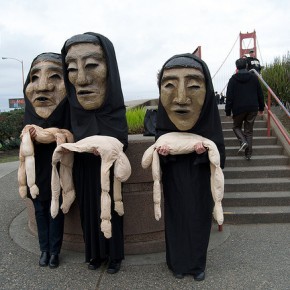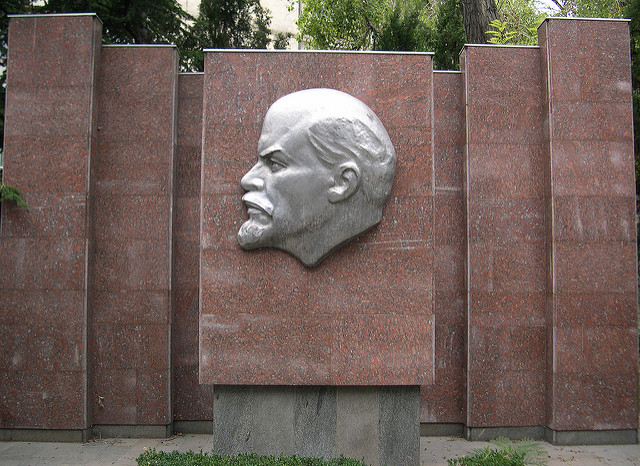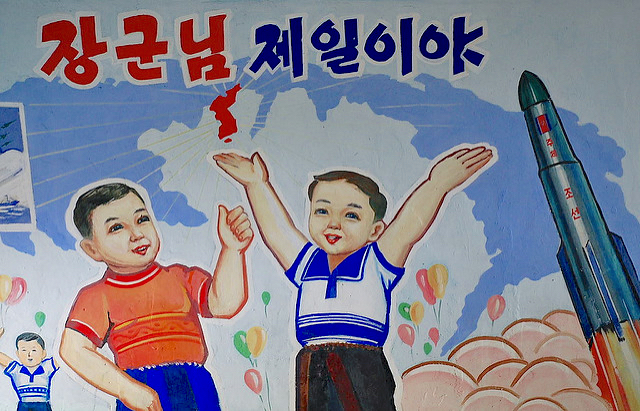Several blocks away from our apartment in Beijing’s Haidian district, a retro ‘red’ restaurant stands alongside the street. Its walls are decorated with photos of Mao Tse Tung and Zhou Enlai along with applauding Communist Party cadres. All the famous faces are here, with many enlarged photographs hanging on the walls and dining booths. The only one missing is deposed Party secretary Liu Shaoqi, whom only political spoilsports and reactionary pedants would remember.
Waiters dressed in PLA fatigues serve earthen pots of especially good chicken soup. A big brass statue of Mao is at the door to greet patrons, a large red scarf spread upon his shoulders. The restaurant’s imposing street sign features a young woman soldier calling “Comrades – dinner is ready!” Facing opposite her, working-class heroes with arms raised demand revolutionary cuisine: “Serve the people!” Or, one wonders mischievously, is the real political call for another beer to help swallow that spicy Jiangxi cuisine? Jiangxi province was the heartland of the Chinese Revolution and the restaurant’s public image calls upon that history.
Beyond its regional cuisine, the restaurant would be otherwise indistinguishable from the many good eating establishments along this tree-lined residential avenue. Its marketing strategy of militant nostalgia is what sets apart this restaurant. While this strategy can be located within the relentless pursuit of marketing themes by Beijing restaurants – Zen Cool, one popular but tasteless bistro, used a prison theme – the broader context is that of heavy-handed official encouragement of nostalgia for post-revolutionary culture until the 1966 Cultural Revolution.
It is nostalgia for a laundered version of a carefully specified period — the Second World War, the Revolution, and pre-Cultural Revolution Maoism. Nationalism and the advent of a successful social revolution provide organizing themes for this nostalgia. The 1958-61 Great Leap Forward, its starvation, violence, and millions of dead disappear, as do the absence of electoral democracy and social freedoms. Rather, this nostalgia represents a carefully-shaped and officially-enforced portrait of a golden era of national unity. The restaurant decor is vulgar nostalgia based on highly selective history. It attempts to please patrons and official ideology simultaneously.
Forms of nostalgia matter. China’s case of official nostalgia is much different from the Ostalgie of former East Germany and eastern Europe. Post-communist fetishization of communist-era commodity culture is not a demand for socialism. Ostalgie is a commercial aesthetic, not a voiced political program. The defunct east German communist party, the Socialist Unity Party (SED), is not returning to power, even in its reconstituted and renamed form within Die Linke (The Left). In China, the Communist Party never disappeared. Here the emphasis is on a continuity of revolutionary legitimacy, a legacy guarded by the Party.
The Chinese version of nostalgia that defends political legitimacy begins with local manifestations created in response to Communist Party recommendations and then expands to national stages. In honor of the Party’s recent 90th anniversary, for example, municipalities organized ‘red song’ festivals to celebrate this period’s revolutionary culture, trying to prevent it from becoming a geriatric preserve. China’s government-controlled television networks produced massive ‘red song’ special programs with phalanxes of choirs. Yet the culture has been emptied of content since few if any want to enact the radical spirit of many such songs.
The implicit potential of this ‘red nostalgia’ wave is being employed by some as a means of indirect criticism of the post-1976 changes and capitalist economics promoted by Deng Xiaoping and his successors. From this perspective, nostalgia functions as social camouflage for a neo-liberal economic regime managed by a once-revolutionary party that today responds to the demands of capital rather than labor. The party of yesteryear remains pure at heart, this nostalgia suggests, even if all of its features have changed other than its continued rejection of electoral democracy, free political association, and free speech.
Communist Party values and corporate values emphasizing acceptance of a decision-making hierarchy controlled by a self-chosen elite have realized their symbiotic correspondence in contemporary China. Nostalgia festivals that broadcast with casts of thousands and over-done technical flair naturalize this symbiosis. Revolutionary patriotism and neo-liberal development merge in visual rhetoric of social advance guided by a corporate-style board of directors for the nation, the Party. Rhetorical reversion to a now-emptied earlier form mystifies the transition to neo-liberalism, translating it as a realization of the ideals of the Revolution. The revolution was not hollowed out, rather it was improved into a consumer-friendly version.
This form of nostalgia capitalizes on an ideological feature of developmentalism that accompanied the Chinese and other revolutions. Nostalgia becomes a marker for where modernization began, where the state started to emerge from backwardness into economic power. Michael Hardt and Antonio Negri argue in Commonwealth that communist programs of development have been as intensely devoted to the concept of modernization through social dominance as capitalist programs, thus “perversely repeating the figure and structures of power in the capitalist countries they oppose.” According to this problematic paradigm of developmental imitation, catching up involves becoming better capitalists than the Western capitalists.
Large and logical social questions emerge from this state policy choice. If only neo-liberal capitalism can achieve material prosperity, why did China pursue ideological phantoms for decades after 1949? If the Party denies its historical self and chooses capitalism in all but name, why not reject the contemporary Communist Party as a vestigial faux-revolutionary remnant? If during over a half-century after its establishment in 1921 the Chinese communist movement criticized capitalism for its historic relationship with colonialism, how does that understanding operate today in light of China’s embrace of capitalism as the inevitable glue of globalism? Where did anti-capitalist resistance disappear?
Such critiques provide a counterpoint to the Party’s insistent banner slogans proclaiming its ‘correct’ choices. These suppressed critiques voice domestic social disenchantment and pervasive cynicism toward the Communists. Nostalgia helps resolve and smooth over popular disenchantment, initiating re-enchantment through state-sponsored spectacle. State power and continued political domination by a monolithic Party leadership rely on once-again re-narration of foundational triumph, a story that culminates in the present-day achievement of national dreams and promise of an even greater future. Nostalgia provides a foundation for the narrative of anti-capitalism turned ‘guided capitalism’ that in turn envisions a new teleology of unstoppable progress.
So by organized celebration of a superficial history, one devoid of critical edge, modernization can become the focus rather than the original anti-capitalism that motivated the revolutionaries who took power in 1949. The ever-present and nostalgic revolutionary song “Without the Communist Party, there would be no new China” has for three generations promised that the Party will lead the country toward modernity (“TÄ lÇngdÇŽo ZhÅngguó zÇ’uxià ng guÄngmÃng” / “[the Party] leads China toward brightness”) and a new consciousness. This was the promise of modernization. The prevailing Chinese version of neo-liberalism instead relies on the unspoken substitution of ‘capitalism’ for ‘Communist Party’ in these song lyrics and their eponymous title. Citizens can be both good communists and good capitalists.
In the Chinese context, nostalgia becomes a form of ‘harmonization.’ This neo-Confucian term, rendered as an ironic passive verb (beì hé xié), means ‘to make someone or something disappear.’ Just as the restaurant walls present a carefully framed and officially-edited history, mass production of nostalgia provides an instrument of polite but coercive harmonization. Under this regime of modernization, opposing opinion and democratic expression get expunged. Instead, a false social unification directed by central authority becomes a leading feature of official popular culture. The falsification of such national unity messages lies in the autonomy of local cultures. In China as elsewhere in neo-liberal societies, autonomous cultures resist ideological dictation and read such messages through lenses of irony and cynicism.
For those sitting down to eat or passing by, the restaurant’s nostalgic aesthetic functions at the levels of street marketing, compliance with official ideology, government-tailored history, and – in a reversal of its original anti-capitalism – popular mobilization for neo-liberal policies. Whatever the restaurant’s decorative motifs, Jiangxi-style food here is tasty despite its orthodox ideological service.
Photograph courtesy of the author





